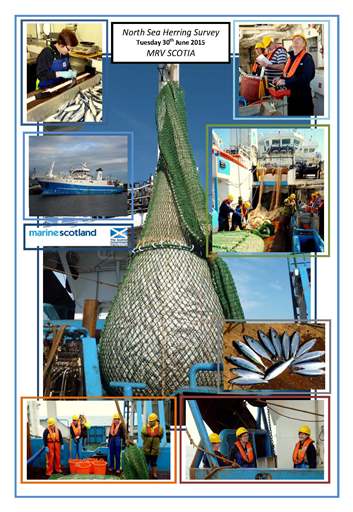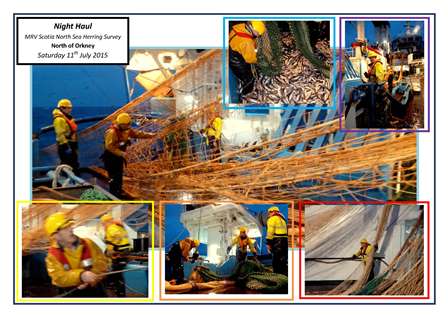Marine
MRV Scotia: Survey 0815S Programme
June 14, 2015 by Marine Directorate Communications No Comments | Category Compliance, Marine Directorate general, Marine Directorate Science, Research Vessel Surveys
Herring Survey Programme
Duration: 25 June – 14 July 2015
Sampling Gear:
- Midwater trawls PT160;
- Multisampling pelagic cod-end with one fine mesh cod-end;
- Seabird 19plus CTD;
- GoPro cameras x 2 with underwater housings and lights;
- Scanmar trawl eye sensor; and
- Towed Hydrophone array.
Objectives:
- To conduct an acoustic survey to estimate the abundance and distribution of herring in the north western North Sea and north of Scotland between 58º30’-62ºN and from 4ºW to 2ºE;
- To obtain biological samples for echosounder trace identification using a pelagic trawl;
- To test feasibility of using GoPro cameras mounted in the net and on a dropframe to further aid in species identification in the echogram scrutiny process;
- To obtain samples of herring for biological analysis, including age, length, weight, sex, maturity and ichthyophonus infection;
- To obtain hydrographic data for comparison with the horizontal and vertical distribution of herring; and
- To obtain acoustic recordings of cetaceans during the survey using a towed hydrophone system.
Procedure:
All fishing gear and scientific equipment will be loaded o nto the vessel on 22 June. Marine Scotland staff will fit acoustic transducers for control of the multisampler net to the drop keel prior to sailing. The vessel will depart Aberdeen on 25 June and after required vessel drills, make passage to Scapa Flow, Orkney Islands, where calibration of all echosounders will take place (approximately 8-12 hours at anchor). Crew training and trial deployments of fishing gear and the multi sampler will take place en route as required by the fishing master.
nto the vessel on 22 June. Marine Scotland staff will fit acoustic transducers for control of the multisampler net to the drop keel prior to sailing. The vessel will depart Aberdeen on 25 June and after required vessel drills, make passage to Scapa Flow, Orkney Islands, where calibration of all echosounders will take place (approximately 8-12 hours at anchor). Crew training and trial deployments of fishing gear and the multi sampler will take place en route as required by the fishing master.
The survey will commence after calibration and follow a pattern of parallel transects running east/west, at normal steaming speed (10.5 knots), progressing northwards, up the east side of Orkney/Shetland, and southwards down the west side. The survey area is bounded by 58º30’-62ºN and 04ºW – 02ºE to the 200 m contour. Transect spacing is 7.5 or 15 nm depending on herring densities encountered in previous years. The proposed Scotia survey design is shown in Figure 1. This may be adapted during the survey to maximize area coverage given the time available.
A 24 hour mid survey break will take place on approximately 4 July in Lerwick to allow for the transfer of staff and to comply with the WTD policy. A scientific crew change will take place with R Catarino and J Lawrence (TBC) joining the vessel and E Carlson and M Inglis leaving. A calibration will be conducted either East of Shetland around the mid cruise break or in Orkney at the end of the survey if time permits.
 Acoustic data will be collected at four frequencies (18, 38, 120 and 200 kHz) between 03:00 and 23:00 hours. Fish shoals seen on the echosounder will be identified using a pelagic trawl (PT160). Survey trawling operations will be carried out between two and four times per day at any time between 03:00 and 23:00 hours using the standard PT160 trawl. Where dispersed or layered aggregations are seen, the multisampler cod end may be used unless large aggregations are present in the area. Samples of all species caught will be measured for length to partition the echo integral amongst species and size classes for target strength functions. Fish will also be weighed to establish a length-weight relationship. Otoliths will be collected from a sub-sample of the herring according to the following length stratified scheme to determine age; two per 0.5 cm class below 22 cm, five per 0.5 cm class from 22.5-27.5 cm and ten per 0.5 cm class for 28.0 cm and above. For each herring in the subsample the state of maturity, gonad weight, liver weight, whole and gutted weight, presence of food in the stomach as well as the presence of Icthyophonus infection will be recorded. The maturity scale used throughout the survey will be the Scottish 8 stage scale.
Acoustic data will be collected at four frequencies (18, 38, 120 and 200 kHz) between 03:00 and 23:00 hours. Fish shoals seen on the echosounder will be identified using a pelagic trawl (PT160). Survey trawling operations will be carried out between two and four times per day at any time between 03:00 and 23:00 hours using the standard PT160 trawl. Where dispersed or layered aggregations are seen, the multisampler cod end may be used unless large aggregations are present in the area. Samples of all species caught will be measured for length to partition the echo integral amongst species and size classes for target strength functions. Fish will also be weighed to establish a length-weight relationship. Otoliths will be collected from a sub-sample of the herring according to the following length stratified scheme to determine age; two per 0.5 cm class below 22 cm, five per 0.5 cm class from 22.5-27.5 cm and ten per 0.5 cm class for 28.0 cm and above. For each herring in the subsample the state of maturity, gonad weight, liver weight, whole and gutted weight, presence of food in the stomach as well as the presence of Icthyophonus infection will be recorded. The maturity scale used throughout the survey will be the Scottish 8 stage scale.
A GoPro camera and underwater lights will be mounted in the trawl as required to aid in species identification in the echogram scrutiny process by delivering additional information on time of capture of and composition of the catch. Where traces are seen in untrawlable areas, a GoPro camera may be deployed manually on a small drop frame to investigate the feasibility of using this technique to verify species composition of echosounder traces. This exercise will be conducted with the vessel in DP.
A towed hydrophone will be deployed over the stern roller during survey transects. The hydrophone will remain deployed while the vessel is at survey speed but will be recovered prior to commencement of fishing operations and environmental sampling.
Where required, a vertical hydro dip will be carried out immediately following a pelagic trawl, this will require the vessel to use its DP system to remain on station. The decision to carry out vertical dips will be based on the requirement to achieve one station in each ICES rectangle.
The ships thermosalinograph will be run continuously to obtain sea surface temperature and salinity throughout the survey area.
Figure 1: Survey track Scotia 0815S. Herring Acoustic Survey.


Leave a comment